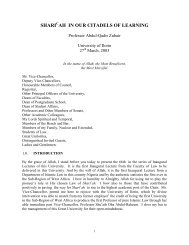THE VARIED ROLES OF SNAILS - National Universities Commission
THE VARIED ROLES OF SNAILS - National Universities Commission
THE VARIED ROLES OF SNAILS - National Universities Commission
Create successful ePaper yourself
Turn your PDF publications into a flip-book with our unique Google optimized e-Paper software.
d. LIFE CYCLE & LIFE BUDGET SUDIES:<br />
Other important things involved in the ecology of snails<br />
include growth rates, key factor analyses, capacity for<br />
increase, net reproductive rate that constitute Life Budget<br />
studies. Iheagwam and Okafor (1984) collected long term<br />
data on the numerical and production changes in Bulinus<br />
globosus and Lymnaea natalensis (gastropods). They<br />
followed the population dynamics and production of many<br />
consecutive cohorts of the snails and found roles for<br />
density and habitat quality in controlling reproductive rates<br />
in the gastropods. They concluded that horizontal (cohort)<br />
life tables were statistically acceptable in such studies and<br />
encouraged its use in the study of other species of<br />
gaqstropods.<br />
To calculate cohort production, the life cycles are often<br />
divided into time intervals while for production in the<br />
snails it will be subdivided into age intervals. Such life<br />
tables are prepared by following the survival of consecutive<br />
cohorts of snails over their life span. Egg production<br />
estimates are used to calculate the net reproductive rates<br />
(RO). From such life tables information on age specific<br />
survivorship rates (LX), age specific fecundity rates (MX)<br />
and mortality rates(qx) are also obtained for each species.<br />
Analysis of the brood years performances usually show a<br />
positive linear correlation. The degree of linearity of the<br />
data collected often suggests how the carrying capacity of<br />
the habitat is declining.<br />
Survivorship data suggest the type of regulation of the<br />
brood size which in itself narrows the number of survivors<br />
at maturity. The survival pattern when integrated with the<br />
reproductive rates often assesses the success or failure of<br />
45

















